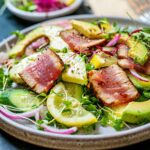Thai desserts are a delightful mix of flavors, textures, and colors that reflect Thailand’s rich culinary heritage. These sweets often incorporate ingredients like coconut, mango, sticky rice, and tropical fruits, offering both exotic and familiar tastes.
If you’re curious about expanding your dessert repertoire, exploring 21 traditional Thai desserts can be a delicious adventure. Each dessert brings unique characteristics and flavors that can captivate your taste buds and provide a new appreciation for Thai cuisine.
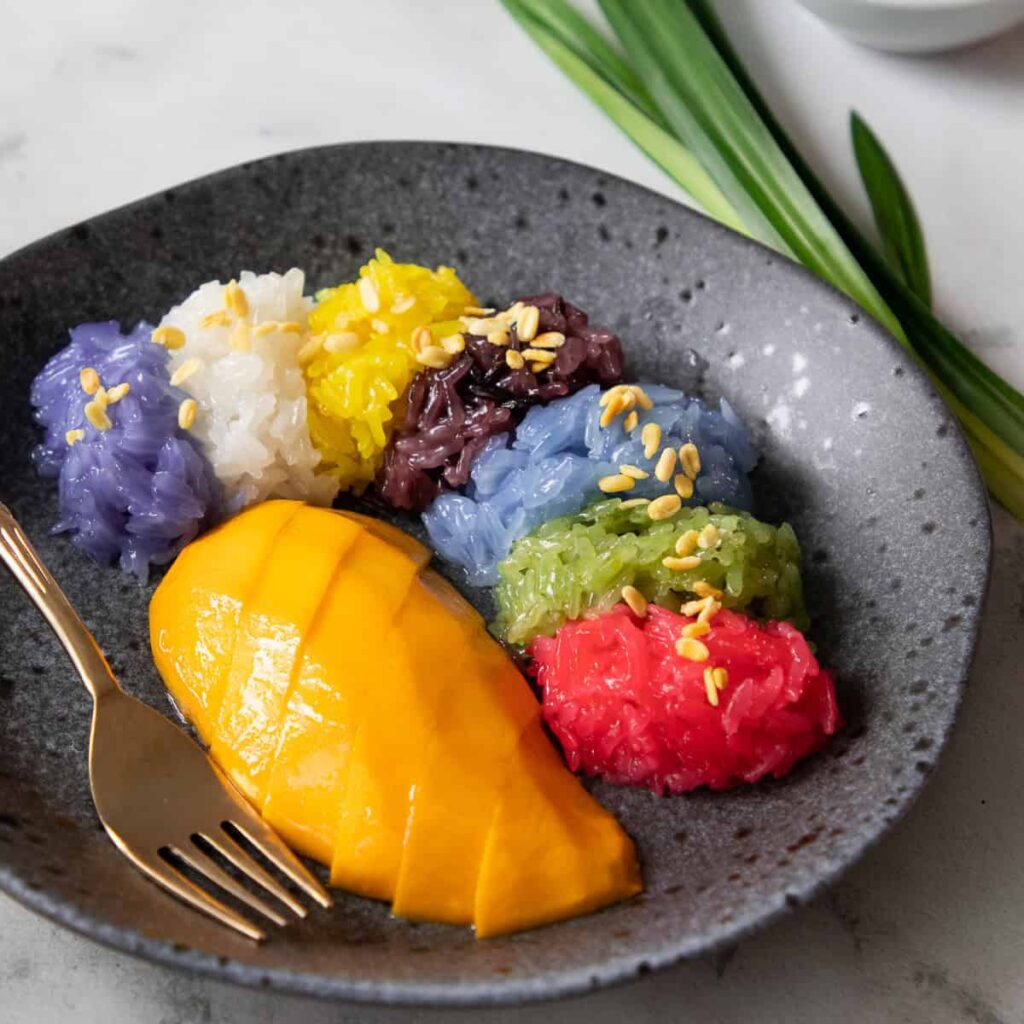
1) Mango Sticky Rice
Mango Sticky Rice is one of Thailand’s most famous desserts. You’ll usually find it sold by street vendors and in restaurants. It’s a simple yet delightful dish that combines sweet, sticky rice with ripe mangoes and creamy coconut sauce.
First, you need to soak sticky rice for several hours or overnight. This helps the grains absorb water and become tender when cooked. Once soaked, steam the rice until it becomes sticky and soft.
To make the coconut sauce, heat coconut milk with sugar and a pinch of salt until the sugar dissolves. Pour this sweetened coconut milk over the steamed rice. Let the rice sit for a few minutes to absorb the flavors.
When you’re ready to serve, slice a ripe mango. Place a portion of the sticky rice on a plate and arrange the mango slices around or on top of the rice. Drizzle more coconut sauce over everything for added sweetness.
Some recipes suggest garnishing the dessert with toasted sesame seeds or roasted mung beans. These add a bit of crunch and extra flavor. Mango Sticky Rice is best enjoyed fresh, while the rice is still warm, and the mango is cool and juicy.
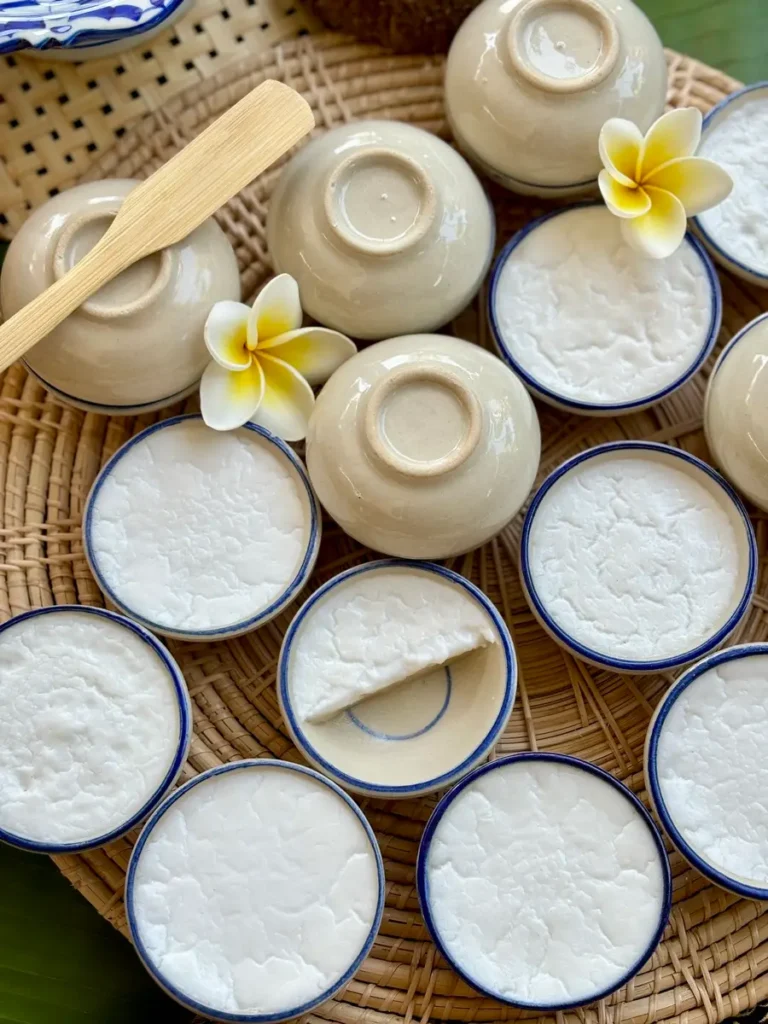
2) Thai Coconut Custard
Thai Coconut Custard is a popular dessert known for its rich and creamy texture. It is called “Khanom Tuay” in Thai. This sweet treat is often served in small porcelain bowls.
To make this dessert, you need rice flour, coconut milk, and sugar. These ingredients are mixed until smooth. Some recipes also blend pandan leaves with the coconut milk for extra flavor.
The mixture is then poured into small bowls and steamed. The result is a soft, melt-in-your-mouth custard. The top layer may have a slightly salty taste, which balances the sweetness below.
Many people enjoy it as a light dessert after a meal. It is also a favorite at festivals and special occasions.
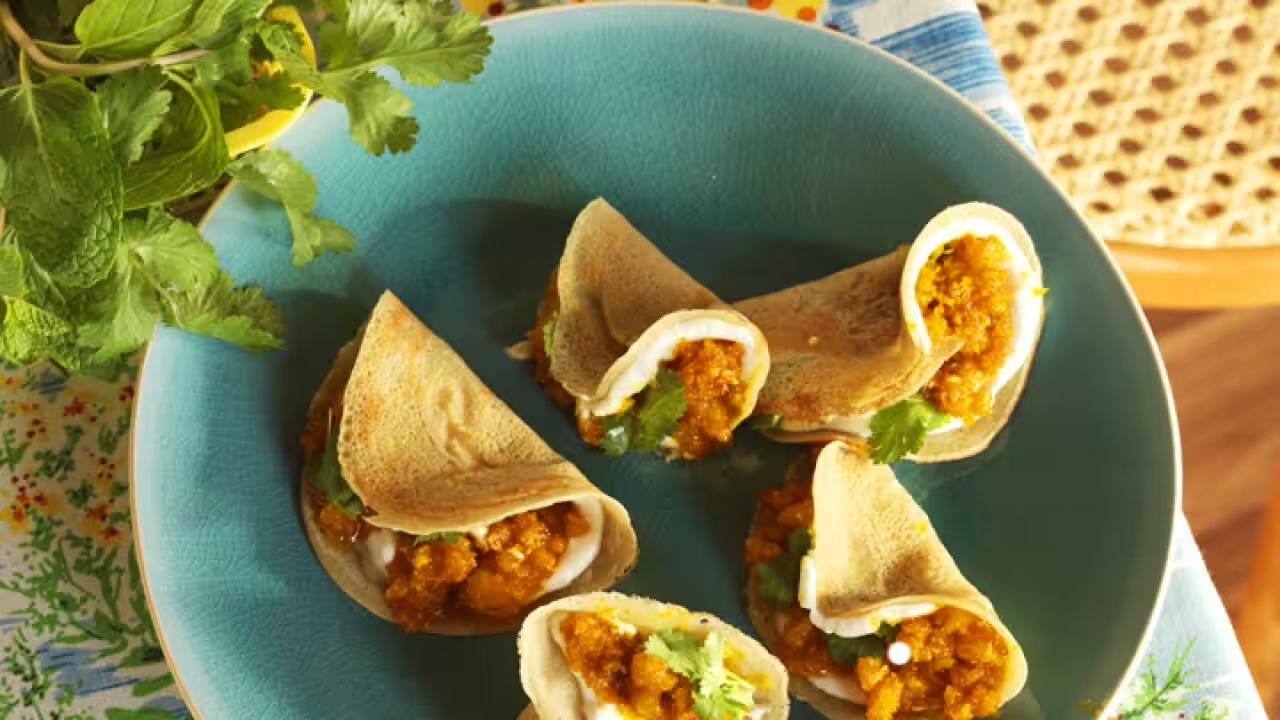
3) Khanom Buang
Khanom Buang, also known as Thai crispy pancakes, is a beloved street food dessert in Thailand. These delightful treats are made with a batter of rice flour, coconut milk, sugar, and water.
The batter is carefully poured onto a hot griddle and spread into thin, round shapes. Once the pancakes are cooked, they are topped with sweet or savory fillings.
Common fillings include fluffy whipped cream and Foi Thong, which are sweetened egg yolks. The pancakes are then folded into a half-circle, resembling a small taco, and are ready to be enjoyed.
Khanom Buang has a long history, dating back to the Ayutthaya period. It continues to be popular due to its unique taste and texture. You can find these tasty treats at many street food stalls throughout Thailand.
Each bite of Khanom Buang offers a delightful crunch combined with the creamy or savory filling inside. They are perfect for anyone looking to try a traditional Thai dessert.
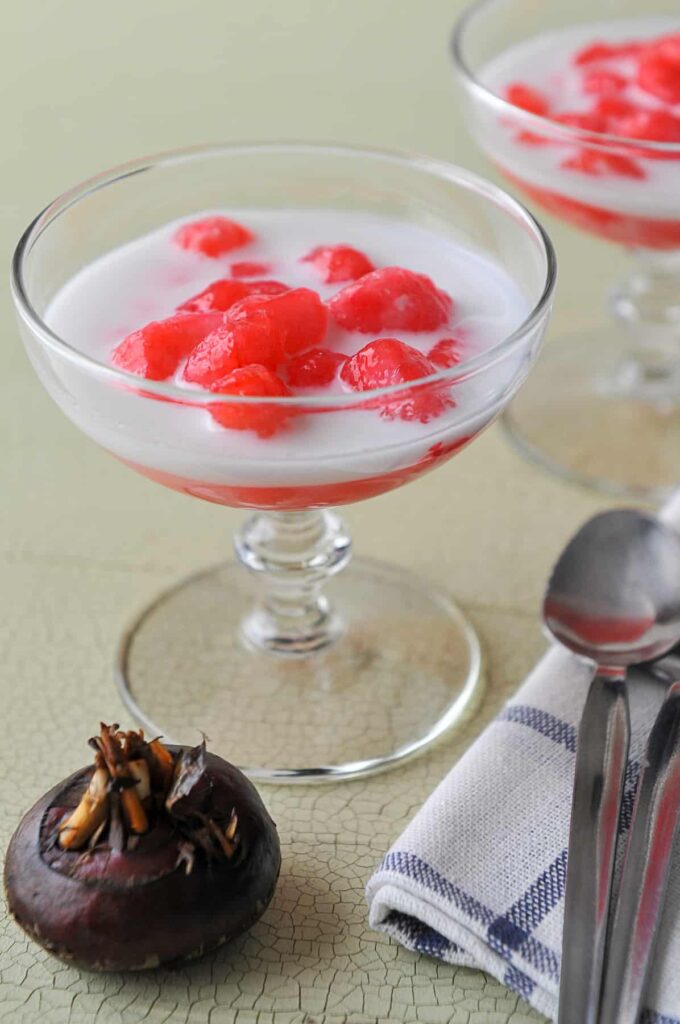
4) Tub Tim Grob
Tub Tim Grob, also known as “Red Rubies,” is a popular Thai dessert. It’s named for its colorful appearance that resembles pomegranate seeds. The dessert consists of water chestnuts coated in red food coloring and tapioca flour.
To make Tub Tim Grob, start with diced water chestnuts. Soak them in water mixed with red food coloring. After they absorb the color, coat them in tapioca flour.
Boil the coated chestnuts in water until they float. This gives them a chewy texture. While they cook, prepare a sweet coconut milk sauce by boiling coconut milk with a pinch of salt.
Once the chestnuts are cooked, drain them and let them cool. Serve them in a bowl of cold coconut milk sauce, often with crushed ice. The combination of textures and flavors makes Tub Tim Grob a refreshing treat, especially on hot days.
Tub Tim Grob is simple to make but delicious. Its mix of chewy chestnuts and sweet, creamy coconut milk is enjoyed by many. It’s one of the standout desserts in Thai cuisine.
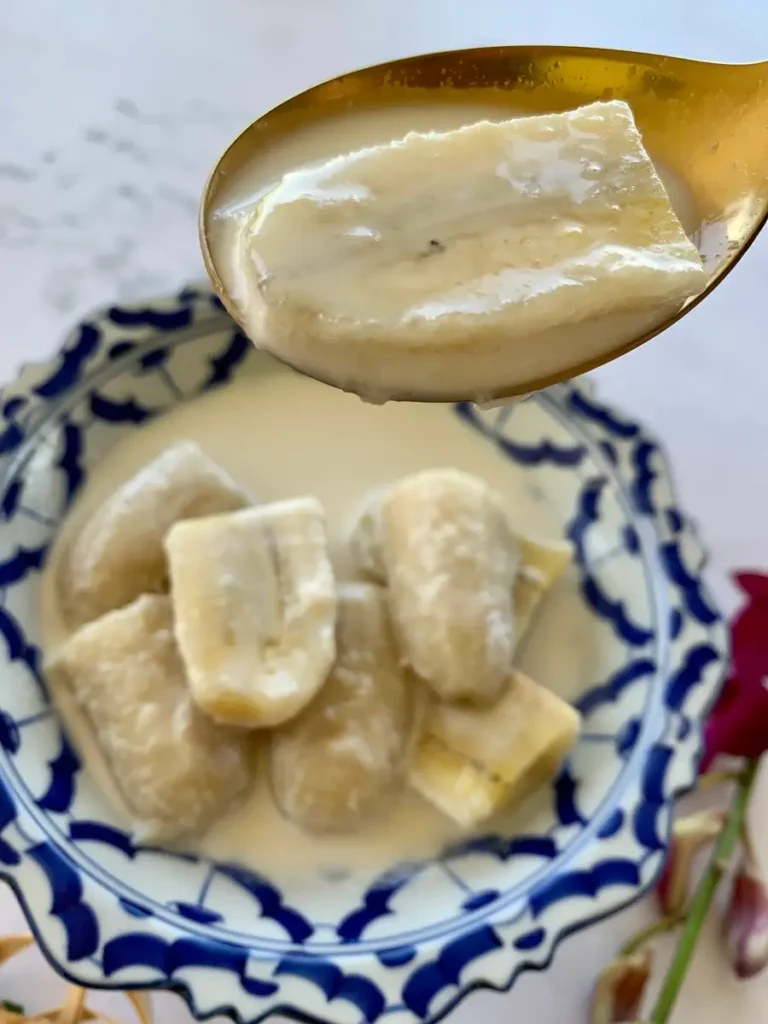
5) Kluai Buat Chi
Kluai Buat Chi is a classic Thai dessert made from bananas and coconut milk. It’s well-loved for its simple yet rich taste. The dish features soft bananas simmered in creamy coconut milk, creating a delightful blend of flavors.
To make Kluai Buat Chi, you start by peeling and slicing ripe bananas into bite-sized pieces. Next, tie pandan leaves into a knot and add them to a pot with coconut milk, palm sugar, and a pinch of salt.
Heat the mixture over medium heat until the palm sugar dissolves. Then, add the banana slices and let them cook until they are tender but not mushy. This usually takes about 5 minutes of simmering.
The dessert can be served hot, at room temperature, or chilled. Each serving gives you a taste of authentic Thai flavors with minimal effort. It’s a versatile dessert that is also popular in neighboring countries.
Whether you’re hosting a Thai-themed dinner or simply craving something sweet, Kluai Buat Chi is a must-try dish. Its easy preparation and delicious taste make it a favorite for many.
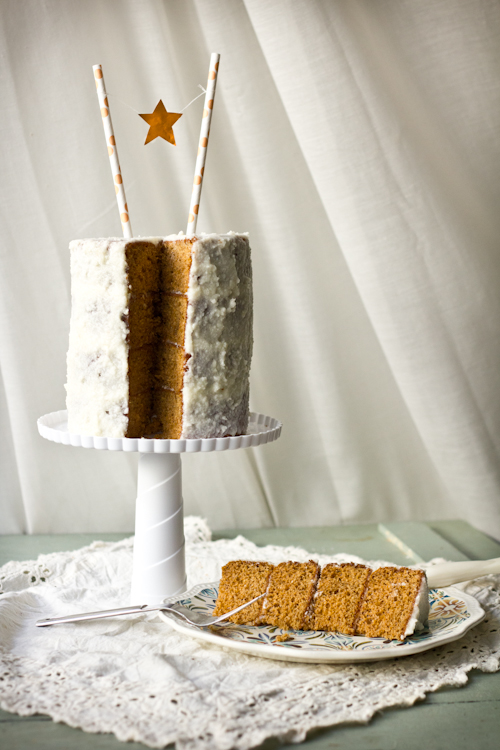
6) Thai Tea Cake
Thai Tea Cake is a delightful dessert that combines the rich flavors of traditional Thai tea with the soft texture of cake. You start by mixing flour, salt, and baking powder in a bowl. In another bowl, beat butter and sugar until fluffy. This creates a light and airy base for the cake.
Next, you add eggs, one at a time, ensuring each is fully incorporated before adding the next. This step is crucial for achieving the right texture. Then, you blend in the Thai tea mixture, which infuses the batter with its unique flavor.
Pour the batter into a greased cake pan and bake at 350°F until a toothpick comes out clean. This usually takes about 30-35 minutes. While the cake bakes, you can prepare a condensed milk custard sauce.
To make the sauce, warm whole milk, evaporated milk, and condensed milk together. Stir occasionally until it steams. Then, whisk in Thai tea powder and let the mixture steep. Once the cake cools, drizzle this creamy sauce over it for an extra layer of flavor.
Thai Tea Cake is a unique way to enjoy the flavors of Thai tea in a dessert form. It’s perfect for those who love trying new and exciting treats.
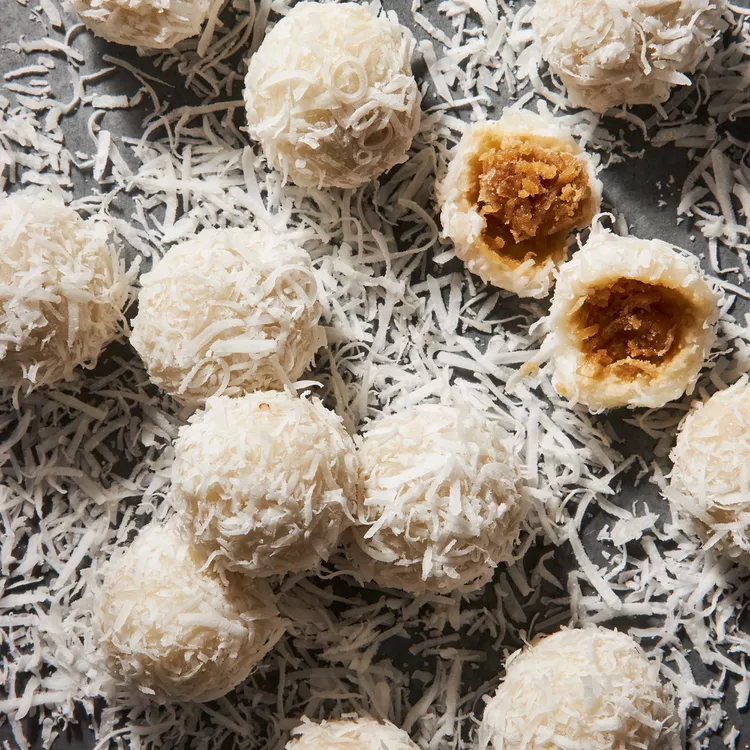
7) Khanom Tom
Khanom Tom is a beloved Thai dessert that offers a sweet, coconut-filled experience. It consists of rice flour dumplings stuffed with a coconut filling. This filling is made from shredded coconut, palm sugar, and sometimes coconut milk.
To prepare, the shredded coconut is mixed with palm sugar and coconut water or milk. This mixture is cooked until it thickens. The dough for the dumplings is made from rice flour, which is then shaped and filled with the coconut mixture.
Once filled, the dumplings are boiled until they float, indicating they are done. They are then coated in more shredded coconut, giving them a unique and delightful texture.
Khanom Tom is often enjoyed during special occasions and festivals. The addition of flower fragrances like from scented candles or pandan leaves adds a distinctive aroma. These simple, flavorful sweets are a testament to the rich culinary traditions of Thailand.
This dessert highlights the use of coconut, an essential ingredient in Thai cooking. With its unique texture and sweet filling, Khanom Tom is a must-try for anyone exploring Thai desserts.
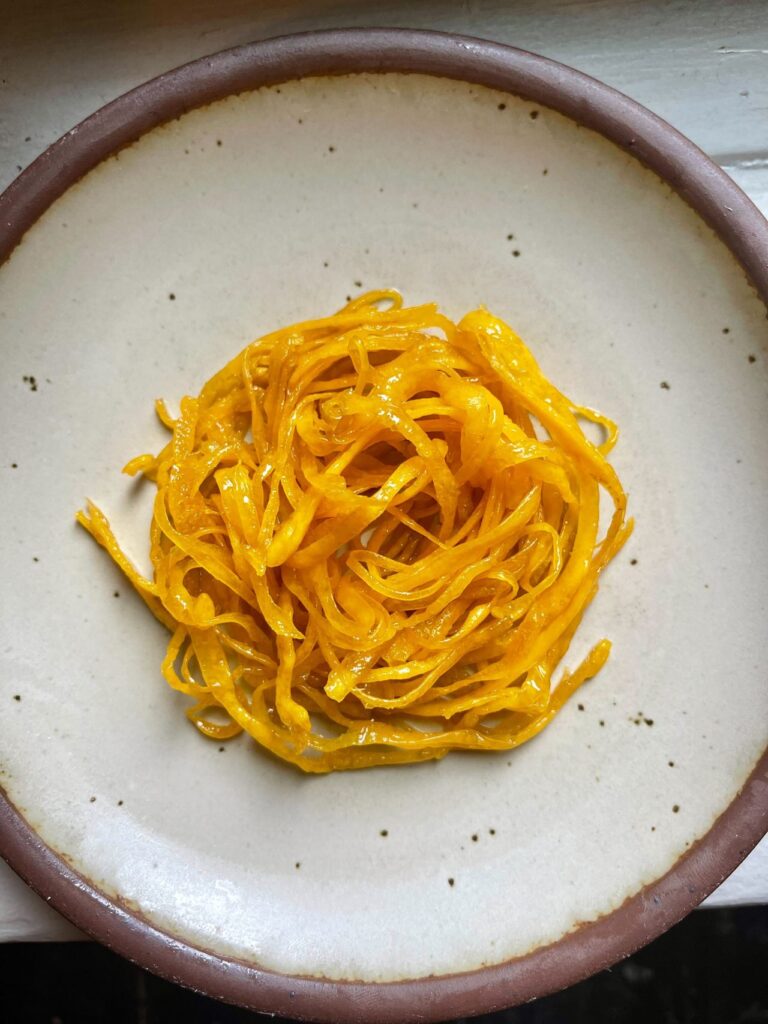
8) Foi Thong
Foi Thong is a well-loved Thai dessert made from duck egg yolks. The name translates to “golden threads” in English. These threads are created by drizzling yolks through a narrow funnel into hot sugary syrup.
Pandan leaves are often added to the syrup. They give the dessert a unique and special flavor. The process of making Foi Thong results in delicate and sweet golden strings.
Foi Thong has its origins in Portuguese desserts. It was introduced to Thailand during the Krung Sri Ayutthaya Period. Today, it’s a popular treat found in markets and sweet shops across Thailand.
You can also try making Foi Thong at home. Start by preparing the syrup with water, sugar, and pandan leaves. Then, blend the yolks and drizzle them into the boiling syrup. Be sure to use a narrow funnel or a small plastic bag with a tiny hole.
This dessert is not only tasty but also visually striking with its bright golden color. Adding Foi Thong to your dessert menu is a great way to experience a piece of Thai culinary tradition.
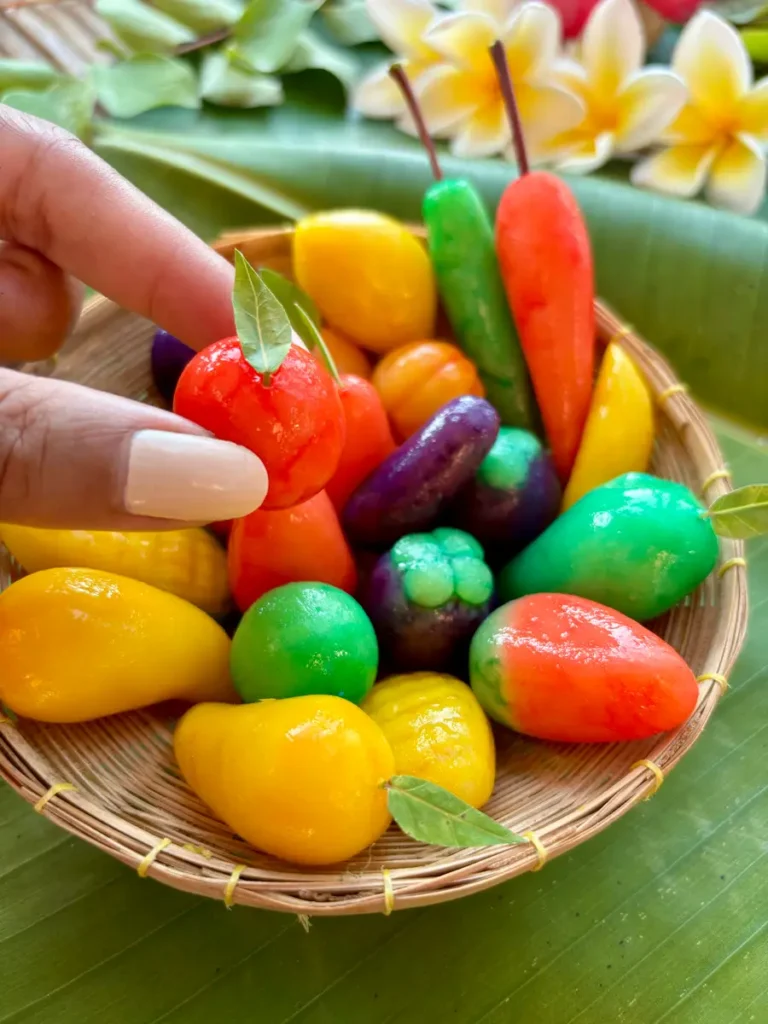
9) Look Choop
Look Choop is a traditional Thai dessert that looks like little fruit sculptures.
Made from mung beans and coconut milk, Look Choop is both tasty and visually appealing. The mung beans are first soaked and steamed, then blended with coconut milk and sugar until smooth. The mixture is then cooked until it thickens and turns into a dough-like paste.
Once the paste cools, small portions are shaped into miniature fruits like mangoes, cherries, and oranges. The tiny fruits are then painted with edible food colors to make them look realistic and shiny. Each piece is a delightful work of art.
The process of making Look Choop is time-consuming but rewarding. The final product is a visually stunning dessert that also tastes delicious. You will be impressed by the skill and patience required to create these sweet treats.
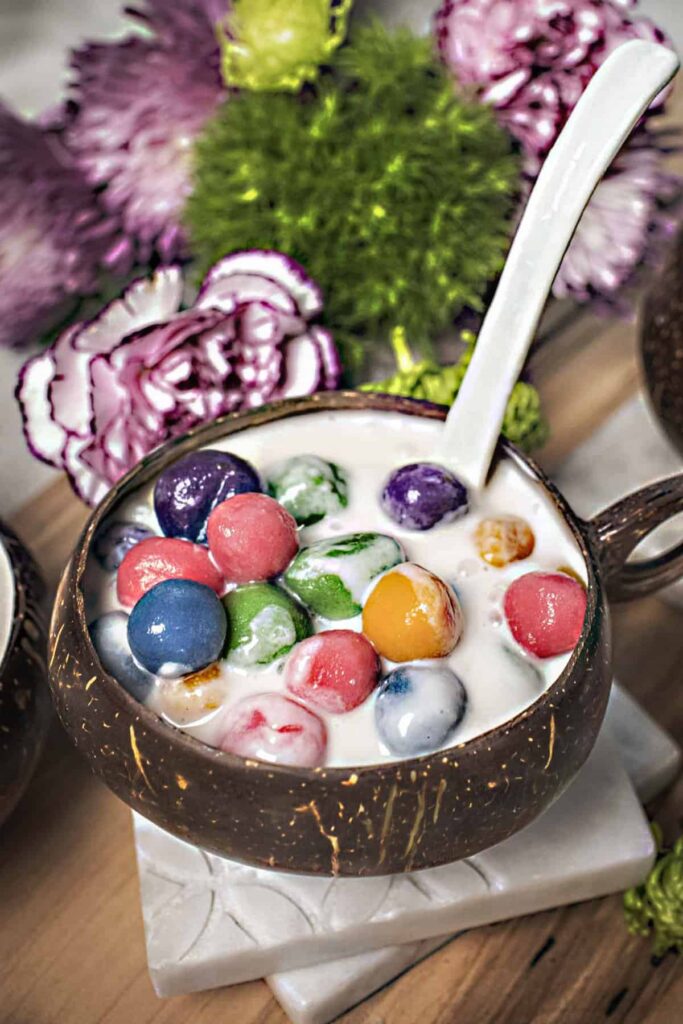
10) Bua Loi
Bua Loi is a popular Thai dessert made from glutinous rice balls served in sweetened coconut milk.
To make the rice balls, combine glutinous rice flour with water or coconut milk. Knead until you get a smooth and pliable dough. Form small balls from this dough.
In a pot, heat coconut milk with water, sugar, pandan leaves, and a pinch of salt. Bring it to a boil.
Add the rice balls to the boiling coconut milk. Cook until they float, indicating they are done.
Sometimes, Bua Loi is served with poached eggs. Crack an egg into the boiling coconut milk and let it cook for a few minutes.
For more flavor, you can add natural food coloring to the dough or mix in mashed vegetables like taro or pumpkin.
This dessert is a delightful combination of chewy rice balls and creamy coconut milk. Give it a try for a taste of traditional Thai cuisine.
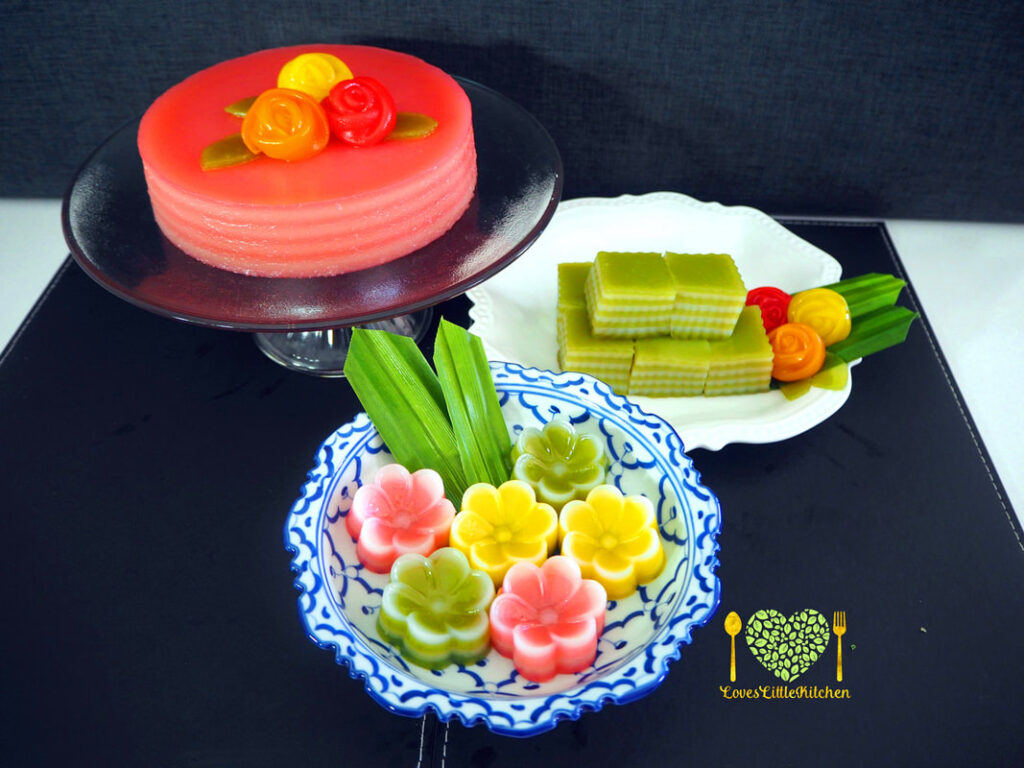
11) Khanom Chan
Khanom Chan is a traditional Thai dessert known for its beautiful layers. It is made using coconut milk and pandan leaves, giving it a unique flavor and smooth texture. Each layer is steamed individually, resulting in a dessert that looks as good as it tastes.
In Thai, “khanom” means dessert, while “chan” means layers. So, Khanom Chan translates to “layered dessert.” The dessert typically features alternating green and white layers, with the green layers getting their color and flavor from pandan leaves.
To make Khanom Chan, you start by blending pandan leaves with water to extract their flavor and color. This green liquid is then mixed with coconut milk, rice flour, and sugar to create the green batter. The white batter consists of the same ingredients, minus the pandan.
The batter is poured into a preheated pan layer by layer, steaming each layer before adding the next. This process is repeated until you have multiple layers of green and white, forming a visually striking dessert. The final product is soft, chewy, and infused with the aromatic scent of pandan and coconut.
Khanom Chan is not just a treat for the taste buds but also a feast for the eyes. Its intricate layers and vibrant colors make it a popular choice for special occasions and festivals in Thailand.
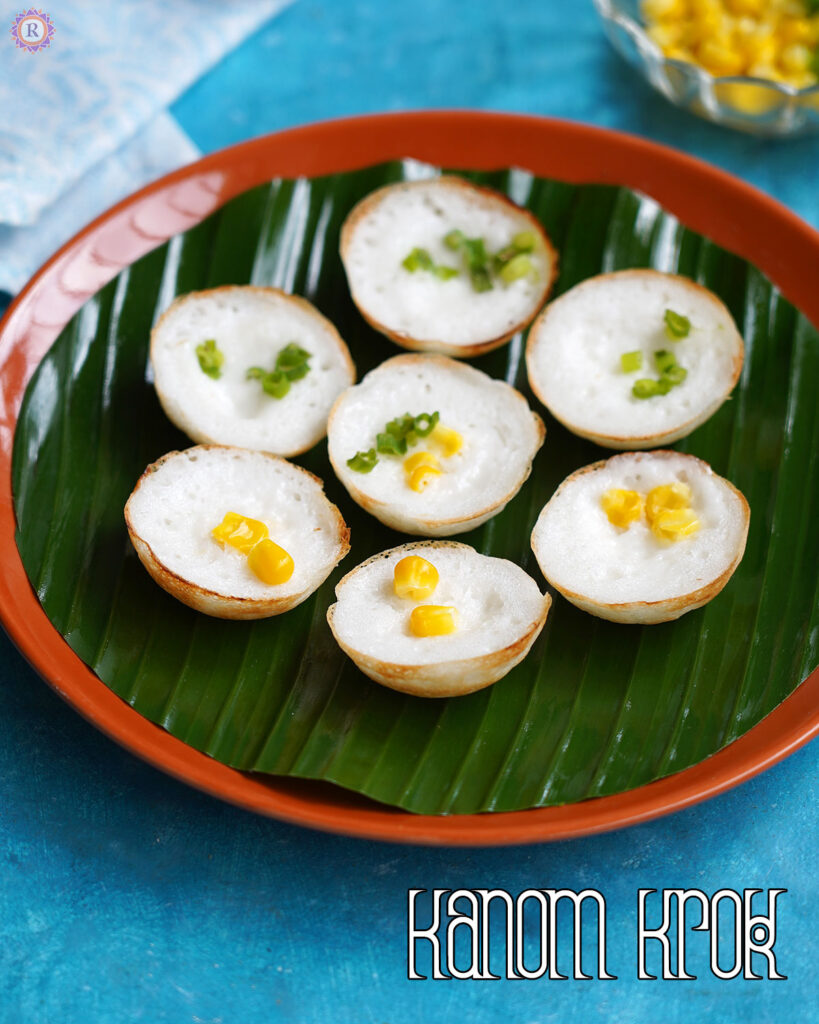
12) Khanom Krok
Khanom Krok is a popular Thai dessert made from coconut milk, rice flour, and sugar. These small, round treats have a crispy outer layer and a soft, creamy center. They are usually cooked in a special pan with small, round indentations.
To make Khanom Krok, you mix the batter ingredients until smooth. Heat the special pan and grease it well. Pour the batter into the pan and let it cook until the edges turn golden brown.
A key step is covering the pan with a lid, which creates an oven-like effect, helping the pancakes cook evenly. Once done, you’ll need a small spoon to gently lift the Khanom Krok out of the pan.
They are best served warm and can be topped with spring onions, sweet corn, or taro. These toppings add extra flavor and texture to the dessert. Khanom Krok is often enjoyed as a snack or a sweet treat at Thai markets.
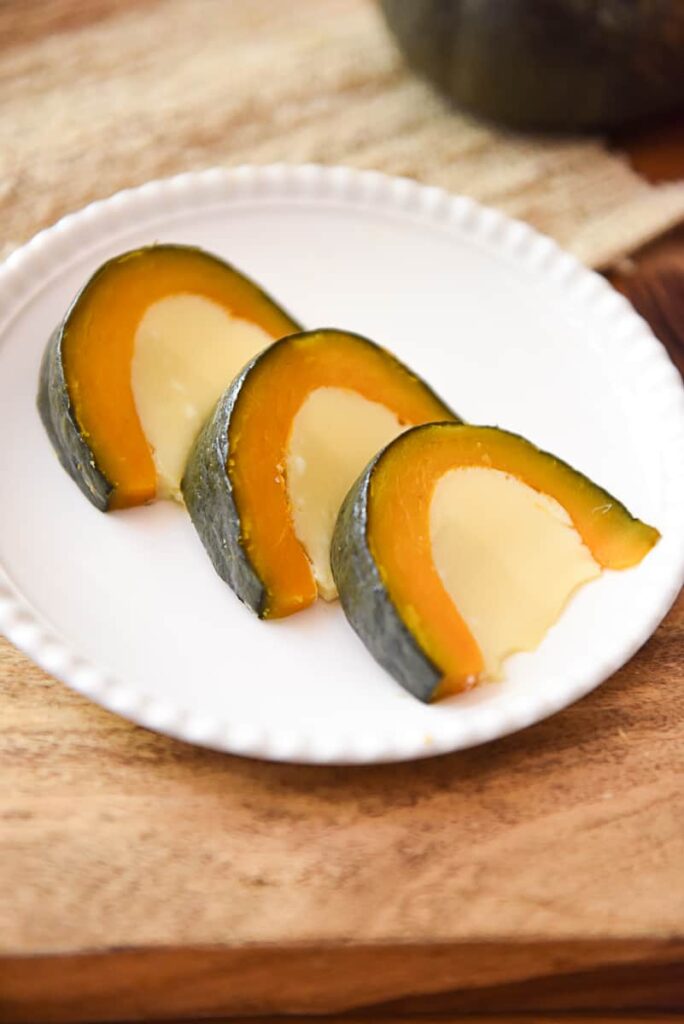
13) Sangkaya Fak Thong
Sangkaya Fak Thong is a traditional Thai dessert. It combines pumpkin and creamy custard. You use small pumpkins, which are filled with a mixture of eggs, sugar, and coconut milk.
First, you cut off the top of the pumpkin and remove the seeds. Then, you mix the custard ingredients like eggs, palm sugar, coconut milk, and a bit of salt.
Pour the custard mix into the hollow pumpkin. Place it in a steamer. Steam the pumpkin with custard for about 45-60 minutes.
To check if it’s ready, insert a toothpick into the custard. If it comes out clean, the dessert is done. Let it cool completely.
You can serve Sangkaya Fak Thong by cutting the pumpkin into slices. It is often chilled before serving. The combination of sweet custard and tender pumpkin creates a delightful taste.
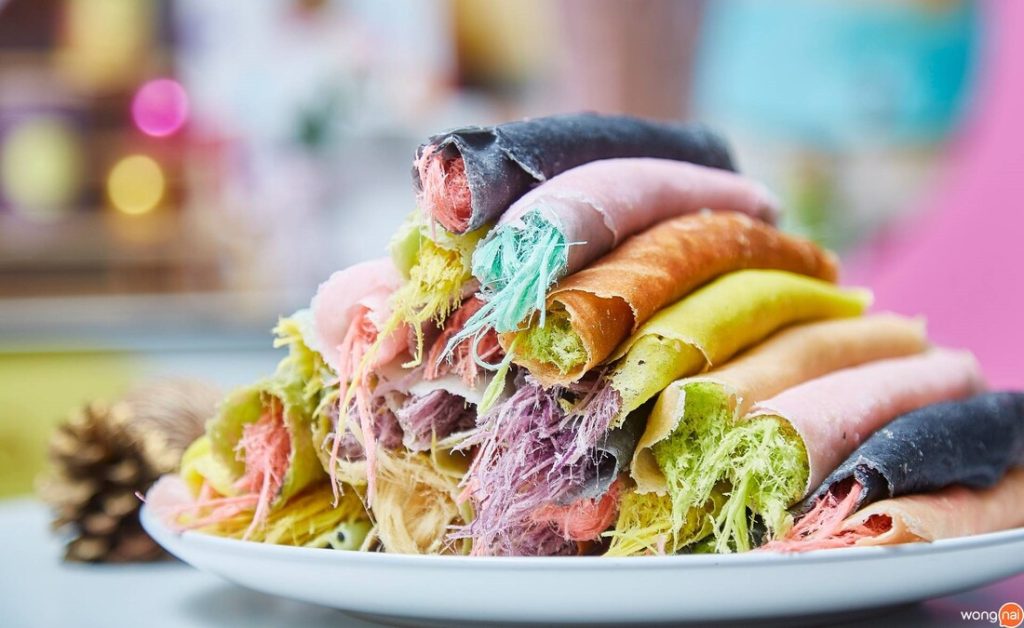
14) Roti Sai Mai
Roti Sai Mai is a popular Thai dessert that originated from Ayutthaya. It combines a thin, pan-fried flour pancake with colorful, fluffy candy floss. The roti is usually made from a mixture of flour and egg, offering a slightly sweet taste.
The candy floss, known as Sai Mai, comes in various colors and flavors. Popular options include Pandan, Strawberry, and Banana flavors. The floss is spun until it becomes light and airy, resembling traditional cotton candy.
It’s believed that Roti Sai Mai was introduced to Thailand by Indian immigrants. Over time, local Chinese communities adapted the recipe by making the roti thinner. This version is the one most people enjoy today.
When you visit Ayutthaya, you can find Roti Sai Mai at many street vendors and markets. It’s often sold in sets of different sizes, ranging from small packs to larger ones you can take home as gifts. Prices usually vary depending on the size of the set.
This dessert is not just confined to Ayutthaya. Many other parts of Thailand also offer it, making it a beloved treat across the country. If you love trying new sweets, this colorful treat is a must.
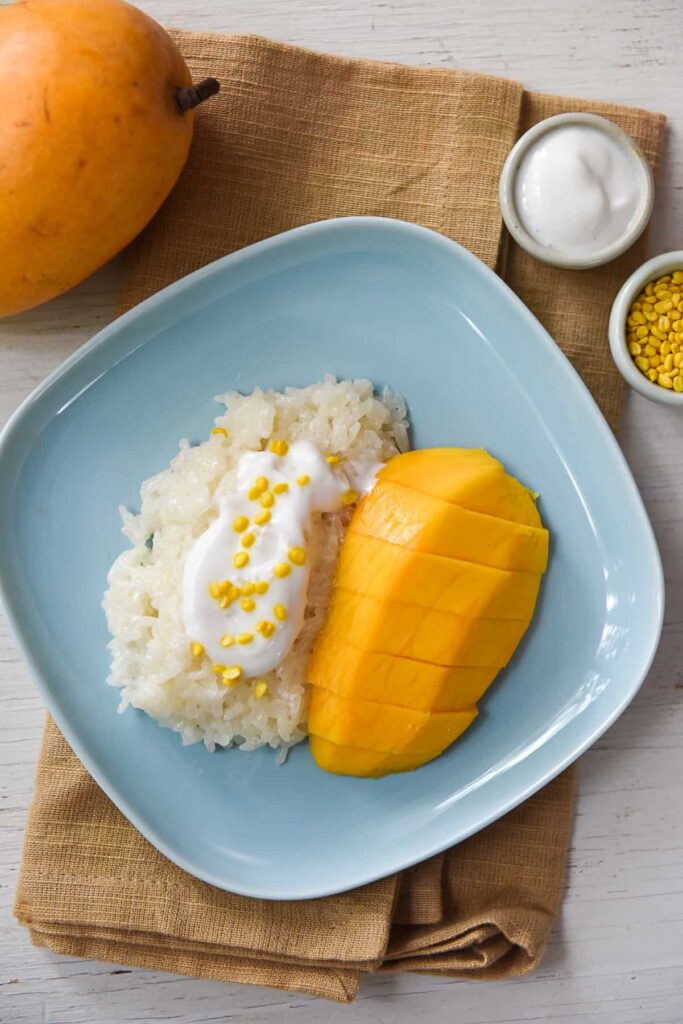
15) Khao Niew Moon
Khao Niew Moon is a traditional Thai dessert made from sticky rice. The rice is first soaked overnight to achieve the right texture. After soaking, the rice is steamed until it becomes translucent, soft, and chewy.
The sticky rice is then mixed with a sweetened coconut milk mixture. This mixture is made by heating coconut milk with sugar and a pinch of salt. You add the hot coconut milk to the freshly steamed sticky rice, gently folding it in until the rice absorbs the liquid.
This dish often comes in different colors, thanks to natural food colorings like pandan leaves or butterfly pea flowers. These colors make Khao Niew Moon visually appealing.
Khao Niew Moon is commonly served with fresh tropical fruits. Mango is a popular choice, but you can also enjoy it with other fruits like ripe banana or durian. The sweet and creamy rice pairs perfectly with the juicy, fresh fruit.
This dessert is a favorite in Thailand and is enjoyed by both locals and tourists. It’s simple yet delicious, offering a perfect blend of sweet and savory flavors.
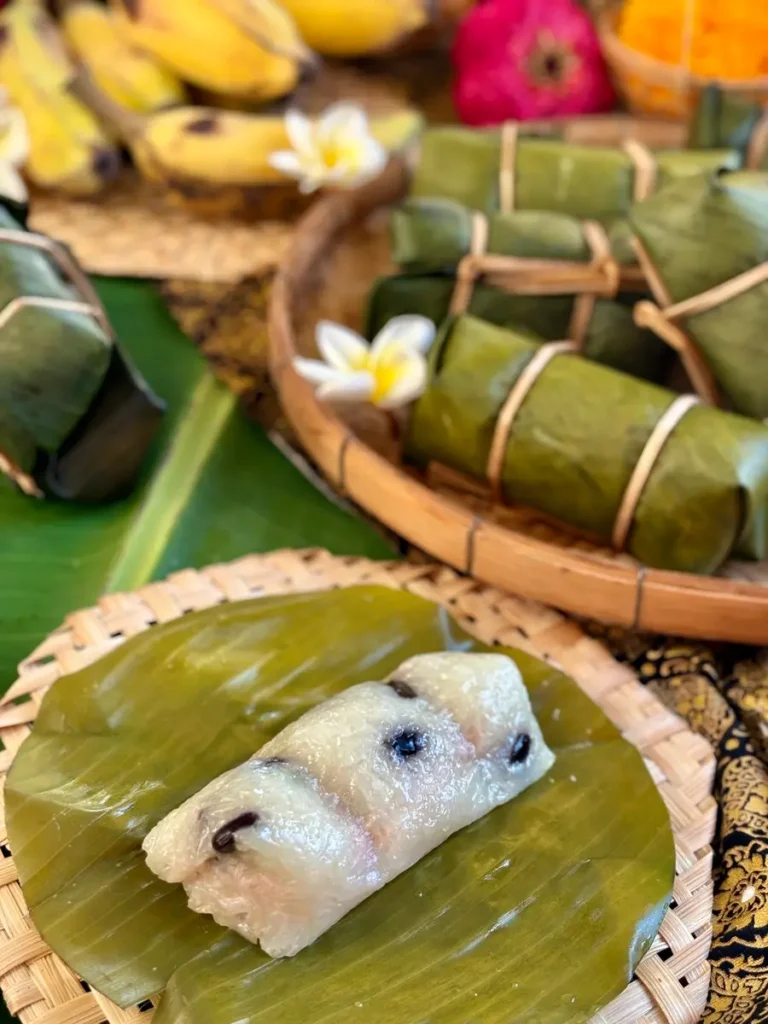
16) Khao Tom Mad
Khao Tom Mad is a traditional Thai dessert made from sticky rice, coconut milk, and banana. It’s a sweet and chewy treat wrapped in banana leaves. You often see it at markets or special celebrations.
To make Khao Tom Mad, you need to rinse and soak glutinous rice for at least four hours or overnight. Then, drain the rice and mix it with coconut milk, sugar, and salt in a pan. Cook the mixture until the rice absorbs the liquid.
After that, the cooled rice mixture is paired with sliced bananas and sometimes black beans. The combination is placed on banana leaves, which are then folded and tied into small bundles. These bundles are steamed until fully cooked, creating a fragrant and delicious dessert.
Khao Tom Mad is unique not only for its flavor but also for its presentation. The use of banana leaves gives it a distinctive appearance and adds a subtle aroma.
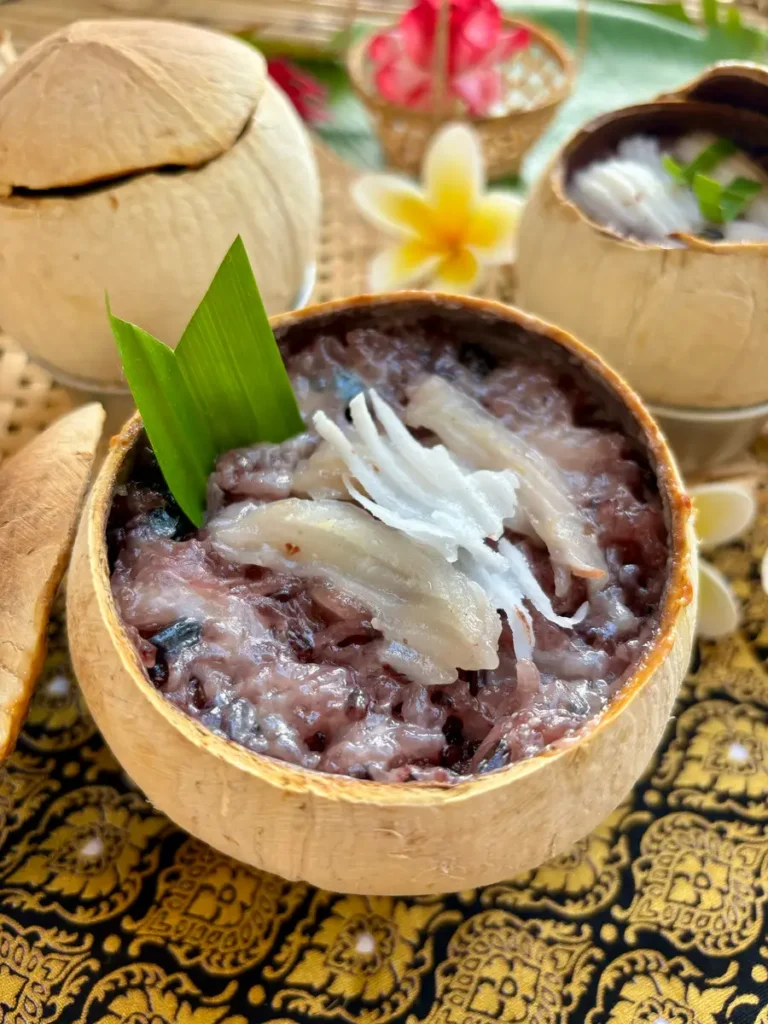
17) Khao Lam
Khao Lam is a traditional dessert from Thailand that many people enjoy. It consists of sticky rice, which can be either white or red, steamed in bamboo tubes. This gives the dessert a unique flavor and texture.
The original version of Khao Lam included only rice mixed with water and salt. Today, you will find more elaborate versions that add ingredients like coconut milk, palm sugar, and red beans. These additions make the dessert sweeter and more flavorful.
The preparation process involves mixing sticky rice with coconut milk and other ingredients. This mixture is then stuffed into bamboo tubes. These tubes are slow-roasted over charcoal until the rice inside becomes soft and creamy.
When you crack open the bamboo, you find a delicious treat. The top part is often custardy and rich, while the bottom part is less sweet and the grains are more separated. This mix of textures makes Khao Lam a delightful dessert to try.
Khao Lam is not only found in Thailand. It is also popular in neighboring countries like Myanmar, Cambodia, and Laos. Each region may have its own twist on the recipe, making it an interesting dessert to explore across Southeast Asia.
You can find Khao Lam in local markets and food stalls, making it accessible for both locals and tourists. If you have a sweet tooth, Khao Lam is definitely a dessert you should try.
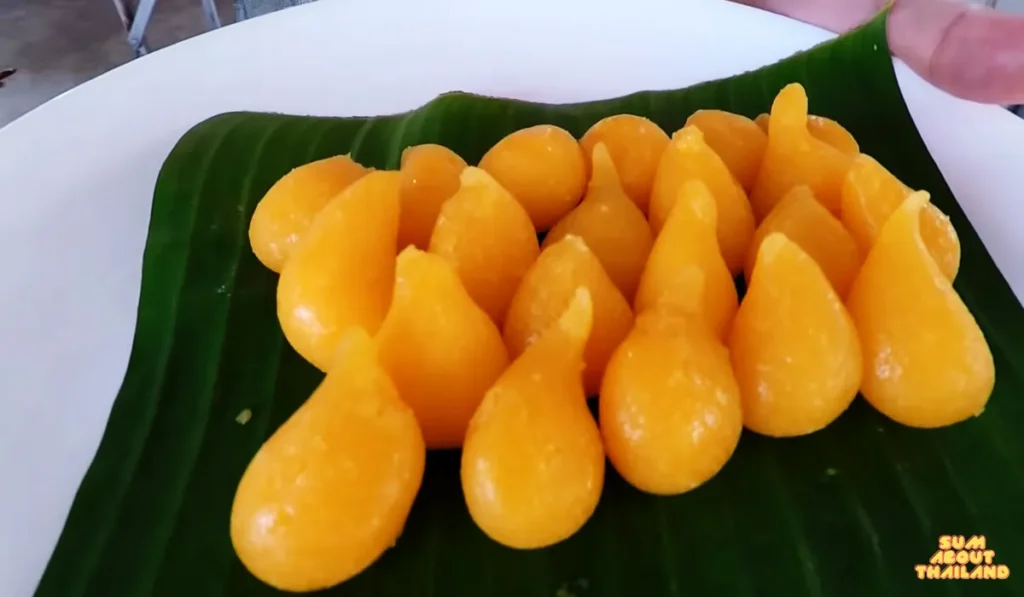
18) Thong Yod
Thong Yod, also known as “gold egg-yolks drops,” is a traditional Thai dessert with a rich history. It originates from a Portuguese dessert called ovos moles de Aveiro, adapted by Maria Guyomar de Pinha in Thailand.
To make Thong Yod, you start by separating egg yolks from the whites. The yolks are then beaten until they become thick and fluffy.
Next, rice flour is mixed into the beaten egg yolks. This combination is then dropped into boiling syrup to cook. The syrup is typically made from sugar and water, cooked until it reaches the right consistency.
Each drop of the mixture forms a small, golden drop. These drops are then removed from the syrup once they are fully cooked.
Thong Yod is part of a family of desserts with names starting with “Thong,” which means gold. These desserts symbolize wealth and prosperity, making them popular in auspicious ceremonies.
The golden color and sweet taste of Thong Yod make it a favorite at many celebrations in Thailand. You will often find it served at weddings and other significant events.
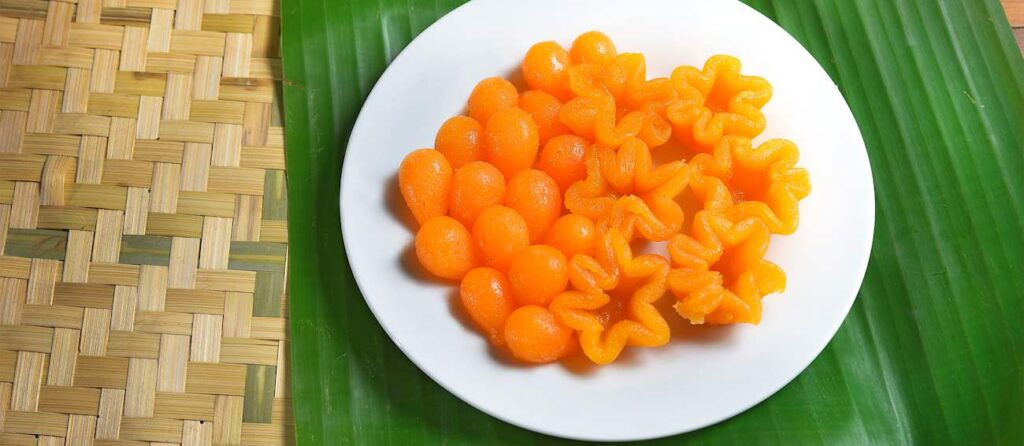
19) Thong Yip
Thong Yip, also known as Sweet Egg Yolk Cups, is a traditional Thai dessert. Its name means “pinched gold” in Thai, symbolizing prosperity and wealth.
This dessert is made using egg yolks, sugar, and jasmine-scented water. Often, a mix of duck and chicken egg yolks is used to create its rich flavor.
Thong Yip is known for its bright golden color and flower-like shape. The folds in the dessert resemble petals, making it visually appealing.
Traditionally, Thong Yip is served at special occasions, such as weddings and blessing ceremonies. Giving this dessert to someone is believed to bring them success and good fortune.
Besides its symbolic meaning, Thong Yip is loved for its sweet taste and unique texture. It holds a special place in Thai culinary traditions.
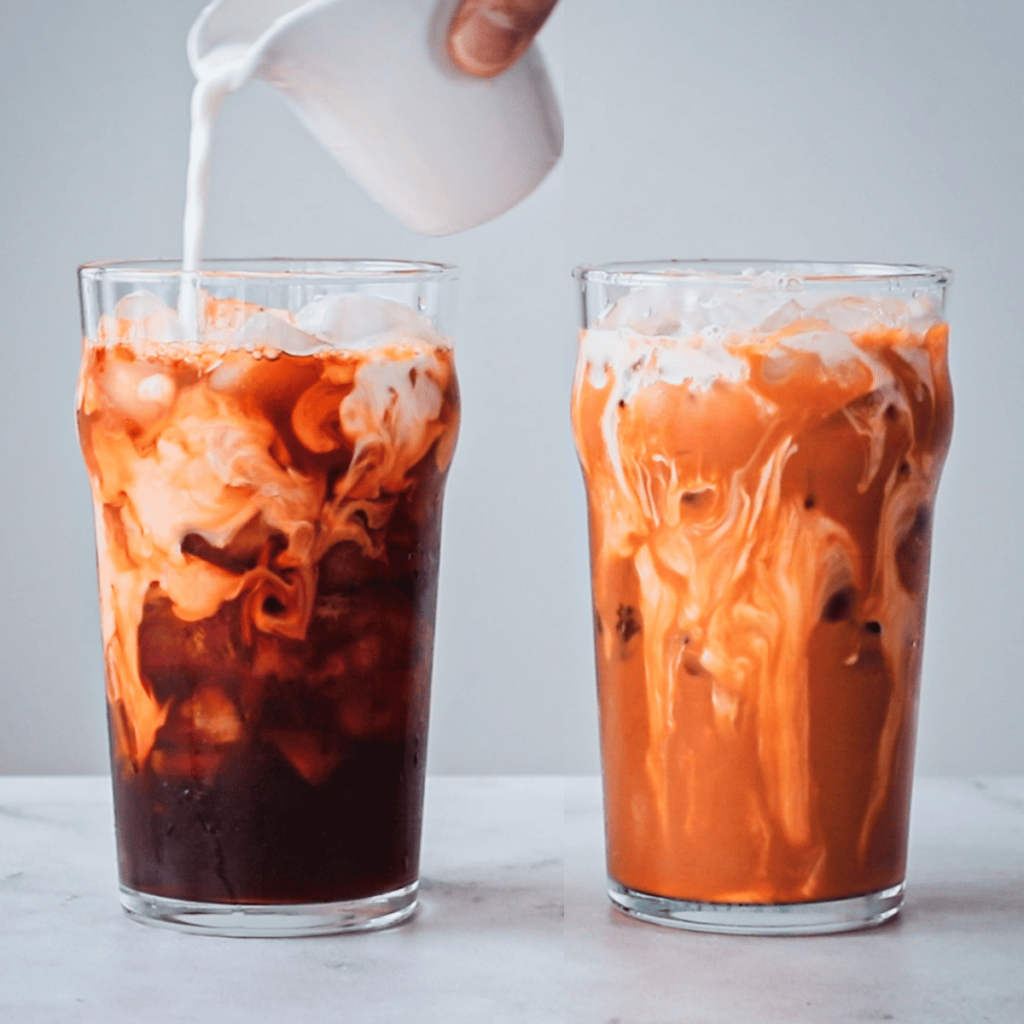
20) Cha Yen
Cha Yen, also known as Thai Iced Tea, is a popular and refreshing drink from Thailand. It is known for its vibrant orange color and sweet, creamy taste.
To make Cha Yen, you start by brewing a strong tea. The tea typically includes a mix of black tea and spices like star anise and cloves.
Once the tea is brewed, add sugar, sweetened condensed milk, and evaporated milk. Stir well until the ingredients are fully mixed.
After letting the tea cool, pour it over a glass filled with ice. The result is a delicious, chilled beverage perfect for hot days.
Cha Yen is often enjoyed with a garnish of mint or a splash of coconut milk for extra flavor.
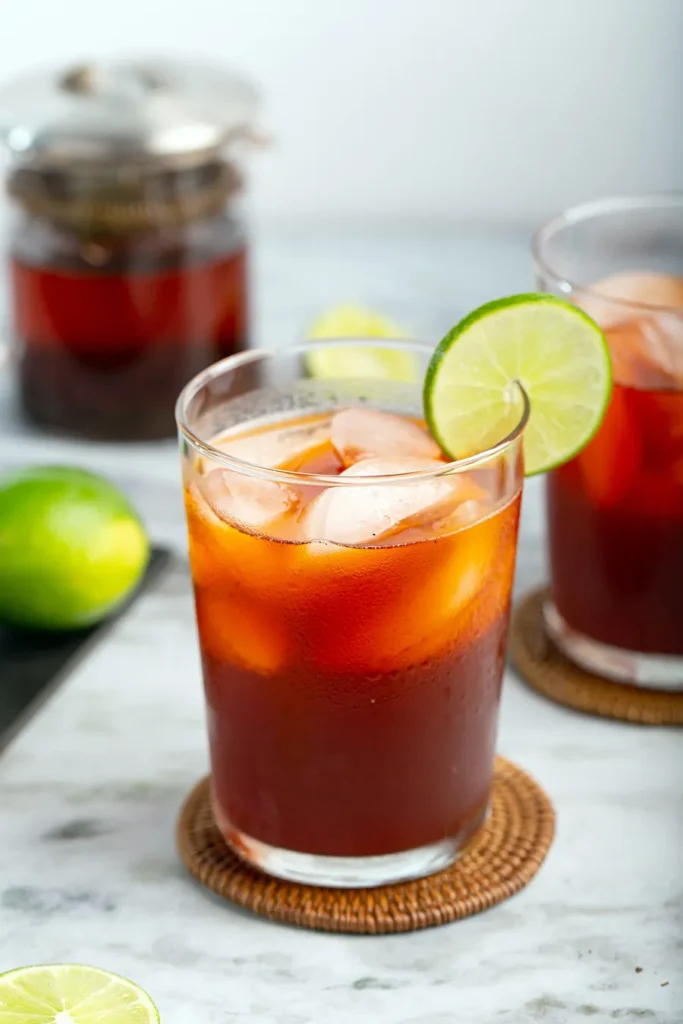
21) Cha Manao
Cha Manao, also known as Thai Lime Iced Tea, is a popular and refreshing drink in Thailand. It’s made using strong black tea mixed with lime juice, sugar, and plenty of ice.
To start, you brew Thai black tea leaves in hot water for a few minutes until it reaches a deep, rich color. You can use a cloth filter or a tea sock for this step.
Once brewed, strain the tea into a pitcher to remove the leaves. Immediately add sugar to the hot tea and stir until fully dissolved. This ensures the sweetness is evenly spread.
Next, let the tea cool down. You can speed up this process by adding an ice cube or two. When the tea is cool, pour it over a glass filled with ice.
Lastly, add freshly squeezed lime juice to the tea in the glass. The amount of lime juice can be adjusted based on your taste preference. Stir well and enjoy your homemade Cha Manao on a hot day.
Cultural Significance of Thai Desserts
Thai desserts reflect the rich history and diverse culture of Thailand. They vary by region, influenced by local ingredients and traditions, which shape their unique flavors and appearances.
History and Tradition
Thai desserts have deep roots in the country’s history. Many recipes date back centuries and are passed down through generations. In the 16th and 17th centuries, Portuguese traders introduced egg-based desserts to Thailand, which led to the creation of sweets like Thong Yip (Pinched Gold) and Foy Tong (Golden Threads). These desserts often symbolize prosperity and long-lasting relationships.
Traditional Thai sweets frequently use ingredients like rice flour, coconut milk, and palm sugar. These components are essential to the flavor and texture of many Thai confections. Special occasions and religious ceremonies often feature specific desserts, each carrying its own auspicious meaning.
Regional Variations
Thailand’s diverse geography results in distinct regional variations of desserts. Northern regions, known for their cooler climates, often include ingredients like black sesame and mung beans in their desserts. In contrast, the southern regions, with their coastal access, favor coconut and palm sugar.
Desserts like Sangkaya Fakthong, a coconut milk custard in pumpkin, highlight this regional specificity. Each area’s unique climate and local produce shape the dessert’s flavor profiles and preparation methods. These regional differences not only add to the variety but also connect the desserts to the local identity and culture.
Key Ingredients in Thai Desserts
Thai desserts use a range of unique ingredients that create their distinct flavors and textures. These include coconut milk, rice, tropical fruits, and pandan leaves.
Coconut Milk
Coconut milk is a staple in Thai desserts. It adds a rich, creamy texture and a slightly sweet flavor. You will find it in many recipes, from coconut mango tapioca pudding to sticky rice with mango.
Benefits of Coconut Milk:
- Rich Flavor: Enhances the dessert’s taste.
- Creamy Texture: Adds body to the dishes.
- Versatile: Used in both sweet and savory dishes.
Rice
Rice is fundamental in Thai cooking, especially in desserts. Sticky rice, in particular, is frequently used. It’s known for its gluey texture, making it perfect for dishes like mango sticky rice or boa loy (sticky rice balls).
Types of Rice Used:
- Sticky Rice: Essential for traditional desserts.
- Rice Flour: Often used to make cakes and thicken puddings.
Tropical Fruits
Tropical fruits add vibrant colors and refreshing flavors to Thai sweets. Mango, banana, and pineapple are among the most popular. They are often used fresh, but can also be found in syrups or dried.
Commonly Used Fruits:
- Mango: Sweet and juicy; pairs perfectly with sticky rice.
- Banana: Used in various forms, including steamed and mashed.
- Pineapple: Adds a tangy twist to desserts.
Pandan
Pandan leaves are used for their unique aroma and natural green color. They are often boiled or blended into desserts. The flavor is subtle but distinct, adding a fragrant note that sets Thai sweets apart.
Uses of Pandan:
- Flavoring: Imparts a slight vanilla-like taste.
- Coloring: Natural green hue for visual appeal.
- Aromatic: Enhances the overall sensory experience.
